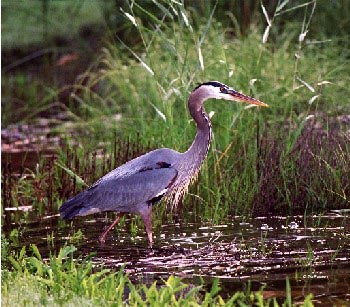
Expanses of tidal marsh, frequently broken by open water, characterize most of the habitat of this WMA. The 13,000 acre property also contains forested wetlands and a 2,800-acre man-made pond or "impoundment." The water insects and crustaceans, as well as the abundance of wigeongrass, horned pondweed and other favorite waterfowl foods makes Deal Island one of the best places in Maryland to watch, photograph and hunt ducks and geese.
What To See
Ducks! Geese! Swans! Waterfowl are the featured performers on Deal Island. Many, many species of waterfowl, in all their colorful splendor, nest, feed and migrate through this area. Deal Island also supports one of the largest concentrations in the state of herons, egrets and ibis. One of Maryland's only breeding population of black-necked stilts thrive here. The rare Eurasian wigeon, a type of duck, is frequently seen in the large flocks of American wigeon that spend the winter in Maryland.
What To Do
Waterfowl are the primary attraction for hunters in Deal Island. No other place in Maryland can boast the chance to see and hunt such large numbers of uncommon ducks like wigeons, pintails, gadwalls, green and blue-winged teal and shovelers in addition to the expected black ducks, mallards, scaup and Canada geese. Crabbing and saltwater fishing are also excellent. Trapping is offered by yearly lease. Hikers and all-terrain bicyclists will enjoy the trail around the marsh impoundment, watching the resting waterfowl or capturing them on film. A primitive camping area is available for overnight stays. Mosquitoes and other biting insects are common from spring through early fall. Bring insect repellent, minimize exposed skin and wear light-colored clothing. Permits are required to hunt the impoundment on certain days.
Area Regulations
- Use of the Deal Island WMA is generally permitted seven days a week throughout the year.
- Hunting is allowed in accordance with open seasons and shooting hours, unless otherwise noted.
- All State and Federal Hunting Laws and Regulations are applicable.
- Waterfowl hunting in the impoundment has specific regulations including permit requirements for certain days and open and closure dates.
For information and permit application click here or call the office listed below.
- The southeastern corner of the impoundment, totaling 800 acres, is designated as a waterfowl refuge and is closed to hunting.
- Trapping is by permit only.
- Dove hunting is restricted to certain days and shooting hours.
- No motorized vehicles are allowed.
 Special Areas
Special Areas
- A 2,800-acre impoundment has been created in the tidal wetlands (small jon boat, canoe, kayak, or chest waders are recommended).
- The southeastern corner of the impoundment, totaling 800 acres, is designated as a waterfowl refuge and is closed to hunting.
- 3,426 acres of Deal Island WMA has been designated part of the MD National Estuarine Research Reserve System.
- A primitive camping area is located off of Riley Robert Road (contact the office below for more information).
Non-hunting Users Guide
- Non-hunting visitors are welcome.
- Be aware of open hunting seasons and visit accordingly.
- Season dates available in newspapers, on the Internet, and at some area stores.
- Trails are maintained and suitable for hiking, nature photography, birding, hunting and other recreational activities, but are not actively marked.
Site Management Goals
- The agricultural fields are planted with crops to provide habitat and winter food for upland wildlife species.
- An impoundment has been created and is managed to provide habitat for waterfowl, wading birds, and aquatic mammals.
- Certain fields are managed dove hunting areas.
- Riparian areas have been planted with trees and grasses to create riparian buffers for water quality and wildlife habitat benefits.
- Some fields have been planted to native warm season grasses, cool season grasses and/or been left fallow to provide habitat for ground nesting wildlife species.
- A peregrine falcon nests on a tower that has been erected as part of the Eastern Peregrine Falcon Recovery Plan.
 Directions
Directions
While the area contains a small island, most of this WMA is located on the mainland. From U.S. Route 13, take MD 363 west from Princess Anne about 11 miles to Deal Island WMA. Marked parking areas located off Deal Island, Riley Robert, and Drawbridge Roads. Boat access via St. Peters Creek, Dames Quarter Creek, Deal Island, Wenona, Big Sound Creek, and North & South Impoundment public boat ramps. For additional information, contact the Wellington Wildlife Office at (410) 651-2065.
 Click Here for Map
Click Here for Map
Photograph of Great Blue Heron Courtesy of Tom Pendleton
This area is a part of Maryland’s Department of Natural Resources public land system and is managed by the Wildlife and Heritage Service. The primary mission of the WMA system is to conserve and enhance wildlife populations and their respective habitats as well as to provide public recreational use of the State’s wildlife resources.
Eighty-five percent of the funding for Maryland's state wildlife programs comes from hunting license fees and a federal excise tax on sport hunting devices and ammunition. The federal aid funds are derived from the Federal Aid in Wildlife Restoration (or Pittman-Robertson) Fund, which sportsmen and women have been contributing to since 1937. Each state receives a share of the funds, which is administered by the U. S. Fish and Wildlife Service; these funds are used for wildlife conservation and hunter education programs, including the management of the WMA system.
Other sources of funds for land acquisition include Program Open Space Funding for Maryland's State and local parks and conservation areas, provided through The Department of Natural Resources' Program Open Space. Established in 1969, Program Open Space symbolizes Maryland's long-term commitment to conserving natural resources while providing exceptional outdoor recreation opportunities.